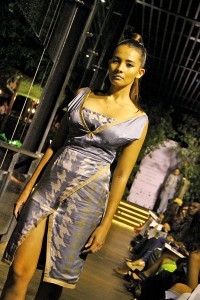Arts
Traditional gets a subtle twist

Yathra: Looking for grey areas in creativity, not what’s black and white. Pix by Indika Handuwala
Batik demands the attention of those who behold it – it is free-spirited and yet still traditional. It can be sophisticated, demure and even subtle, as proven by Yathra Jayawardena’s batik collection which hit the ramp at this year’s Colombo Fashion Week’s (CFW) Emerging Designer show on March 15.
The grand daughter of batik and tie and dye pioneer Swanee Jayawardena, Yathra is no stranger to the world of batik and fashion. A product of Bishop’s College and the British School, Yathra embarked on fashion designing, surprisingly without any formal training. Growing up she had seen that most artists focused on the creative elements of their work but were at times wholly impractical when it came to running a business, usually leaving it to others to manage. Striving to strike a balance while being fully involved in the family business, Yathra chose to follow a degree in economics and business studies at the University of Lancaster in Malaysia.
Selected for Colombo Fashion Week’s (CFW) Project SEVEN, a creative development programme aimed at strengthening designers’ ideation process and broadening their perspectives, in 2016, Yathra says the experience she gained through it was a turning point. The programme helped sharpen her creativity and taught her how to channel it into her designs. It was a journey of self-discovery, as she puts it. Describing it as an epiphany that hits you when you realize that your designs should stem from your own preferences in order to be unique, she emphasises that “it’s not just about following trends”.
Though still an integral part of her late grandmother’s batik business, Yathra is seeking her own path with her brand YATHRA, which was launched this March. Her sense of style, though still rooted in batik, she says, differs very much from Swanee’s. “Her art work was more abstract, and her silhouettes were simpler so that it showcased the artwork on the fabric,” she says. Yathra chooses to focus more on silhouettes, fitted and well constructed firstly, from which point she incorporates the batik artwork.
Aside from CFW being a platform on which to launch her brand and receive publicity for her designs, she is immensely thankful to CFW Founder Ajai Vir Singh and the CFW team for the support they extend to designers both pre and post show.

Yathra’s designs on tha ramp at CFW
Inspired by screen legends Audrey Hepburn and Edie Sedgwick, Yathra’s debut collection sought to emulate the romantic and sophisticated style of 1950’s Hollywood. Created using delicate silk and refined cottons, her collection featured feminine structured and fitted silhouettes that yesteryear Hollywood was known for. These she modernised with deep cuts, plunging necklines and dramatic backs. But what really catches the eye is the subtle yet still very present batik. “You can’t conceal it. It has its own personality. It’s loud in presentation and appearance,” she says about batik, choosing to tone it down with colour and intricacy.
As children, Yathra and her siblings were always encouraged to be creative. From turning the walls in the house into their personal canvases to tearing up material and creating their own designs, very little was off limits. “It was like living in wonderland,” Yathra fondly recalls. But growing up with artists also meant that they held strong opinions on what was considered good art and music. “I grew up listening to Led Zepplin and Pink Floyd. I wasn’t allowed to bring Westlife CDs home,” and perhaps this explains why she’s “so old school” now. She believes that this background has made her an idealist. “I love the music and the movies of that time,” she says.
So it is all about the art and the creative process for her. She refuses to replicate a successful design that is in demand. That defeats the purpose which is to give people unique pieces and wouldn’t push her to keep at being creative, she says.

Yathra’s designs on tha ramp at CFW
A lover of all that is fusion, Yathra believes that while we stay true to our roots in art or culture we shouldn’t be closed off to new ideas or other cultures. “Nothing is built on its own, everything is built on the shoulders of giants,” she says, adding that therefore we should be open to drawing inspirations and elements where-ever we can. “I’ve never been black, I’ve never been white, I like the grey area.” This outlook towards life can certainly be seen in her designs and will probably feature in her future collections where she hopes to fuse batik with elements such as the ‘Kantha stitch’, a traditional Indian embroidery style.
This young designer believes that that is what art is about, and who she is as an artist.

